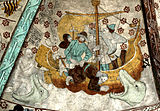Härkeberga Church

Härkeberga Church (
History
Härkeberga Church is built in an old cultural landscape, and close to the church archaeological discoveries have been made of objects from the Bronze Age and Iron Age.[1] The church itself dates from the early 14th century.[2] Few alterations have been made to the original building. The vestry and the main body of the church are original. In the 15th century, a church porch, a single buttress was added and the interior embellished with brick vault, adorned with frescos by Albertus Pictor. It is for these frescos that the church is most well known.[1][2] Since then, no major alterations have been made to the church.[1]
Architecture
The church is a hall church with two windows in the southern wall and a group of three windows in the eastern wall of the choir, all original but later (18th century) enlarged. The attached vestry is original and contains traces of 14th century frescos, imitating masonry. A door with medieval iron decoration connects the church porch (c. 1480) and the church, and in the entrance door traces of the original, medieval cloth that once covered the door remain. Internally, the church is embellished with richly decorated vaults, created by Albertus Pictor.[1] [3]
The frescos date from around 1480 and are unusually well-preserved, since they have not been covered with
Most of the church furnishings date from the 18th century, including the
The church stands in a cemetery, surrounded by a low wall. The gate in the wall is probably medieval but redesigned during the 18th century. The wooden bell tower is from the 17th century; the church has never had a stone tower.[3]
Gallery of frescos
-
View of the triumphal cross, hanging beneath the decorated vault
-
View of one of the vaults
See also
- Church frescos in Sweden
References
- ^ ISBN 978-91-85873-74-6.
- ^ a b "Härkeberga kyrka". Enköping Municipality. 2012-05-31. Archived from the original on 2015-09-24. Retrieved 26 March 2014.
- ^ a b c d "Härkeberga kyrka". upplandia.se. Archived from the original on 2014-03-29.
External links
- Official site (in Swedish) Archived 2014-01-03 at the Wayback Machine
 Media related to Härkeberga Church at Wikimedia Commons
Media related to Härkeberga Church at Wikimedia Commons





